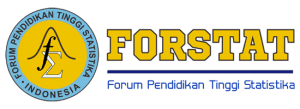PENERAPAN MODEL SPASIAL DURBIN DENGAN UJI LANJUTAN LOCAL INDICATOR OF SPATIAL AUTOCORRELATION UNTUK MELIHAT PENYEBARAN STUNTING DI KABUPATEN BONE BOLANGO
Abstract
One of the spatial regression analysis used is the spatial durbin model (SDM). This model can be applied to obtain the relationship between X and Y variables and their spatial effects. This research was continued by testing the local spatial autocorrelation, namely the local indicator of spatial autocorrelation (LISA) which aims to provide information on the pattern of spatial relationships of each observation area in Bone Bolango regency. Stunting cases in Gorontalo province, especially in Bone Bolango regency, are in a status that needs to be addressed immediately due to the prevalence rate in Bone Bolango regency in 2019 above 20% based on the WHO standard. The results showed that the factors that significantly affected stunting in 2019 in Bone Bolango regency were exclusive breastfeeding, the proper sanitation and poverty. Meanwhile, based on the spatial effect, the factors that significantly affected stunting in 2019 in Bone Bolango regency were the percentage of exclusive breastfeeding, the percentage of LBW, the number of children with CBI and poverty. Based on result from the LISA, the observation areas of stunting cases showed that the percentage of exclusive breastfeeding, the number of children with CBI and povertu had a spatial autocorrelation or forming a grouping on the distribution of the stunting cases, the number of children with IDL and poverty, there are sub-districts that have spatial autocorrelation.
Keywords
Full Text:
PDFReferences
Bivand, R. S. ., Pebesma, E., and Gómez-Rubio, V. (2013), Applied Spatial Data Analysis with R (Use R!), New York: Springer.
Feng, Z., and Chen, W. (2018), "Environmental Regulation, Green Innovation, and Industrial Green Development: An Empirical Analysis Based on the Spatial Durbin Model" Sustainability, 10, 223. https://doi.org/10.3390/su10010223.
Hakim, A. R., Yasin, H., and Rusgiyono, A. (2019), "MODELING LIFE EXPECTANCY IN CENTRAL JAVA USING SPATIAL DURBIN MODEL" MEDIA STATISTIKA, 12, 152. https://doi.org/10.14710/medstat.12.2.152-163.
Kominfo Bonebolango (2021), "Persoalan Stunting di Bone Bolango Harus Segera Selesai" http://kominfo.bonebolangokab.go.id/berita-persoalan-stunting-di-bone-bolango-harus-segera-selesai.html, Available athttp://kominfo.bonebolangokab.go.id/berita-persoalan-stunting-di-bone-bolango-harus-segera-selesai.html.
Lee, J., and Wong, D. (2000), Statistical Analysis With Arcview GIS., New York: Wiley; 1st edition.
Osadebey, M., Pedersen, M., Arnold, D., and Wendel-Mitoraj, K. (2019), "Local Indicators of Spatial Autocorrelation (LISA): Application to Blind Noise-Based Perceptual Quality Metric Index for Magnetic Resonance Images" Journal of Imaging, 5, 20. https://doi.org/10.3390/jimaging5010020.
Ramadani, I. R., Rahmawati, R., and Hoyyi, A. (2013), "ANALISIS FAKTOR-FAKTOR YANG MEMPENGARUHI GIZI BURUK BALITA DI JAWA TENGAH DENGAN METODE SPATIAL DURBIN MODEL" Jurnal Gaussian, 2, 333-342.
Suaib, T. P. A., Junaidi, J., and Fadjryani, F. (2022), "PENERAPAN SPATIAL DURBIN MODEL (SDM) PADA INDEKS PEMBANGUNAN GENDER DI PULAU SULAWESI" Majalah Ilmiah Matematika dan Statistika, 22, 82. https://doi.org/10.19184/mims.v22i1.29581.
Taryono, A. P. N., Ispriyanti, D., and Prahutama, A. (2018), "Analisis Faktor-Faktor yang Mempengaruhi Penyebaran Penyakit Demam Berdarah Dengue (Dbd) di Provinsi Jawa Tengah dengan Metode Spatial Autoregressive Model dan Spatial Durbin Model" Indonesian Journal of Applied Statistics, 1, 1. https://doi.org/10.13057/ijas.v1i1.24026.
Tim Nasional Percepatan Penanggulangan Kemiskinan (2018), 100 Kabupaten/Kota Prioritas untuk Intervensi Anak Kerdil (Stunting), Jakarta: Sekretariat Wakil Presiden Republik Indonesia.
DOI: https://doi.org/10.34312/jjps.v3i1.13083
Refbacks
- There are currently no refbacks.
Copyright (c) 2022 Jambura Journal of Probability and Statistics

This work is licensed under a Creative Commons Attribution-NonCommercial 4.0 International License.







.jpg)






